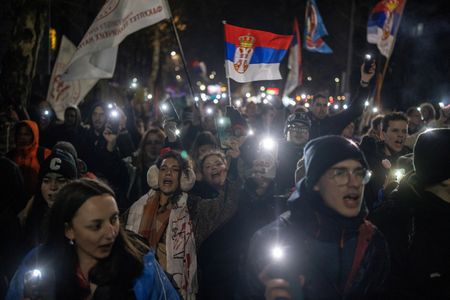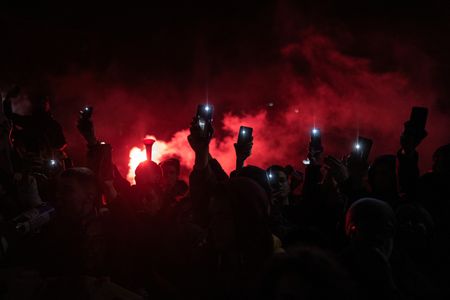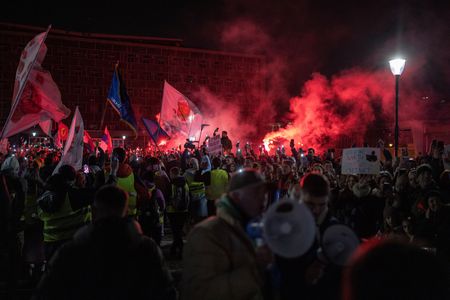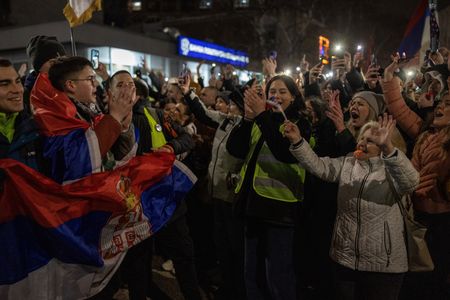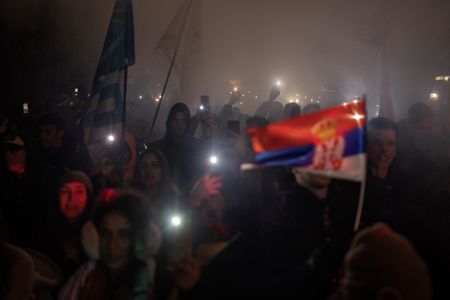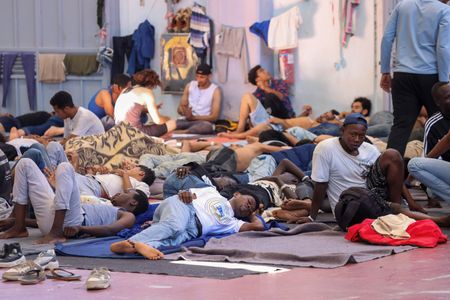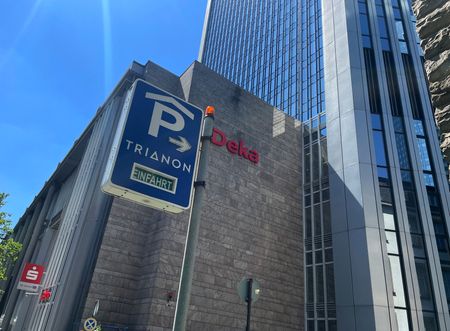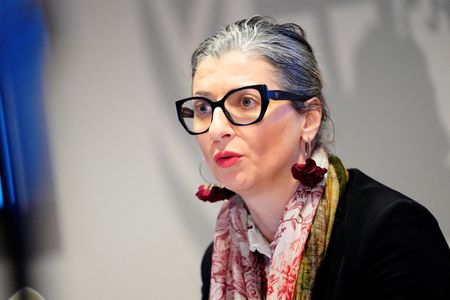By Ivana Sekularac, Aleksandar Vasovic and Edward McAllister
BELGRADE (Reuters) – Anger drove Marija Petrovic to join student protests in Belgrade in November. A railway station roof had collapsed days earlier in the Serbian city of Novi Sad, killing 15 people. Thugs then set upon demonstrators who were calling for justice for the dead.
Initially there was little sign of wider support for the protesters, who blamed government corruption and nepotism for what they say was shoddy construction work on a recently-renovated roof. The government denies the allegations.
Three months on, however, the demonstrations have ballooned into the biggest protest movement in Serbia in years. Joined by tens of thousands of teachers, lawyers and other workers, the highly organised students have taken over faculty buildings, blocked highways and squares and triggered a political crisis.
“Any of us could have been under that roof,” said Petrovic, a student of molecular biology at the University of Belgrade, a focal point of the protests, as she prepared to head to a rally on Thursday.
Serbia’s Prime Minister Milos Vucevic and the ministers for construction and trade have all stepped down because of the disaster, but that has failed to quell people protesting what they say is an autocratic regime.
Students protest daily, and paint their hands red to represent the blood that they say is on the government’s hands. Demonstrators are expected to rally in the city of Kragujevac on Saturday in what may be the largest gathering yet.
Five students who spoke to Reuters say the protest’s success so far is down to their strict organisation, clear demands, daily coordination, and a lack of hierarchy that has made it hard for the government to target leaders. Even the spokesperson changes daily.
Students sleep in university buildings, living on food and drink donations. Lectures have stopped. The protest message is tightly controlled: that the government must do its job properly and honestly, and that the demonstrations will not end until it does.
The students have not called for the overthrow of President Aleksandar Vucic. But their persistence has created one of the biggest threats to the president’s long grip on power, political analysts said.
“Vucic finds himself in what is probably the most vulnerable position since his party first formed the government in 2012,” said Mario Bikarski, senior Europe analyst, at risk consultancy Verisk Maplecroft.
“The perception of corruption remains the key issue for protesters, who are likely to remain active until they receive meaningful guarantees on the issue.”
UNDER PRESSURE
Vucic became prime minister in 2014. In 2017, he was elected president, a traditionally ceremonial role which he has bolstered by maintaining influence over his SNS party.
He is seen as a strategic player internationally, given Serbia’s historic ties with Russia and the West. But opposition parties and rights watchdogs accuse him and his SNS party of bribing voters, stifling media freedom, violence against opponents and ties with organised crime.
Vucic and his allies deny these allegations. But Serbia’s rating on Transparency International’s global corruption index has worsened gradually in recent years. It now sits 105th out of 180 countries.
The students’ demands include the publication of documents related to the station roof collapse; justice for those responsible; the dismissal of charges against protesting students; and a greater budget for higher education.
Vucic says he has met those demands.
Prosecutors in December indicted 13 people over the awning collapse, including the former minister of infrastructure, who denied responsibility.
“I hope that the blockades will stop, they are destroying our economy,” he said in an address this week.
Students are unmoved.
WORKING TOGETHER
The students’ efficiency is down in part to the overhaul of their own structures. The old student parliament at the University of Belgrade has been replaced with plenums – daily assemblies where each faculty votes on its course of action.
Working groups focus on strategy, donations and security. Universities in different cities coordinate so demands remain broadly aligned.
Students have set up a website that lists their needs: from pastries and meats to soft drinks and sleeping bags. People stop by to drop off supplies.
Funds are coming in too.
Serb national Nenad Milanovic runs an IT company in the U.S. city of San Francisco. He helped set up a funding website for the students that has raised $73,000 so far.
“Students in Serbia do not need to worry. People support them and they will always have enough money,” Milanovic told Reuters by phone.
“They are young, they have energy and they have nothing to lose.”
(Editing by Alexandra Hudson)

